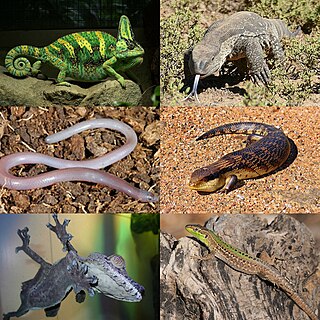
Lizards are a widespread group of squamate reptiles, with over 7,000 species, ranging across all continents except Antarctica, as well as most oceanic island chains. The group is paraphyletic since it excludes the snakes and Amphisbaenia although some lizards are more closely related to these two excluded groups than they are to other lizards. Lizards range in size from chameleons and geckos a few centimeters long to the 3-meter-long Komodo dragon.

The Phrynosomatidae are a diverse family of lizards, sometimes classified as a subfamily (Phrynosomatinae), found from Panama to the extreme south of Canada. Many members of the group are adapted to life in hot, sandy deserts, although the spiny lizards prefer rocky deserts or even relatively moist forest edges, and the short-horned lizard lives in prairie or sagebrush environments. The group includes both egg-laying and viviparous species, with the latter being more common in species living at high elevations.

Phrynocephalus is a genus which includes 33 species of small and medium-sized agamid lizards, commonly called toadhead agamas or toad-headed agamas, that inhabit open arid and semiarid environments of Asia and Eastern Europe. The systematics of this genus are very complicated with many controversial points of view about the unclear phylogeny of this group. All representatives of this genus have adopted the so-called "sit and wait" hunting strategy and they actively use visual orientation when watching for food. In general, the ecological niche and role of Phrynocephalus species in lizard communities of arid environments of Asia are poorly studied, but seem to be similar to that of Phrynosoma, Cophosaurus, Holbrookia, Uta, and Sceloporus in the New World, as well as Moloch in Australia.

Urosaurus is a genus of lizards, commonly known as tree lizards or brush lizards, belonging to the New World family Phrynosomatidae.
Side-blotched lizards are lizards of the genus Uta. They are some of the most abundant and commonly observed lizards in the deserts of western North America, known for cycling between three colorized breeding patterns and is best described in the common side-blotched lizard. They commonly grow to 6 inches including the tail, with the males normally being the larger sex. Males often have bright throat colors.

The western fence lizard is a common lizard of Arizona, New Mexico, California, Idaho, Nevada, Oregon, Utah, Washington, Northern Mexico, and the surrounding area. As the ventral abdomen of an adult is characteristically blue, it is also known as the blue-belly.
Edward Harrison Taylor was an American herpetologist from Missouri.

Leonhard Hess Stejneger was a Norwegian-born American ornithologist, herpetologist and zoologist. Stejneger specialized in vertebrate natural history studies. He gained his greatest reputation with reptiles and amphibians.

The common side-blotched lizard is a species of side-blotched lizard in the family Phrynosomatidae. The species is native to dry regions of the western United States and northern Mexico. It is notable for having a unique form of polymorphism wherein each of the three different male morphs utilizes a different strategy in acquiring mates. The three morphs compete against each other following a pattern of rock paper scissors, where one morph has advantages over another but is outcompeted by the third.

Petrosaurus mearnsi, also called the banded rock lizard, is a species of lizard in the family Phrynosomatidae. The species is native to western North America.

The western long-tailed brush lizard is a species of lizard in the family Phrynosomatidae. The species is native to the southwestern United States and adjacent northern Mexico.
The dunes sagebrush lizard, formerly known as the sand dune lizard and the dunes-sagebrush lizard, Sceloporus graciosus arenicolus, a subspecies of sagebrush lizard), is an insectivorous spiny lizard species which only occurs in the shinnery oak sand dune systems of extreme southeast New Mexico and only four counties in adjacent Texas. Sceloporus arenicolus has the second-smallest range of all lizards in the United States.
Isla San Lorenzo Sur, is an island in the Gulf of California east of the Baja California Peninsula. The island is uninhabited and is part of the Mexicali Municipality. Isla San Lorenzo Norte is located immediately northwest of Isla San Lorenzo Sur.
Islotes Blancos, is an island in the Gulf of California east of the Baja California Peninsula. The island is uninhabited and is part of the Mexicali Municipality.
The dead side-blotched lizard is a species of lizard. Its range is in Mexico. The specific name, lowei, is in honor of American herpetologist Charles Herbert Lowe.
The Isla San Pedro Nolasco lizard is a species of lizard. Its range is in Mexico.
The San Pedro side-blotched lizard is a species of lizard. Its range is in Mexico.

The Isla Santa Catalina side-blotched lizard is a species of lizard. It is endemic to Isla Santa Catalina in the Gulf of California, Mexico. This species of lizard can be as long as 2.2 inches.
The swollen-nosed side-blotched lizard is a species of lizard. Its range is in Mexico.










